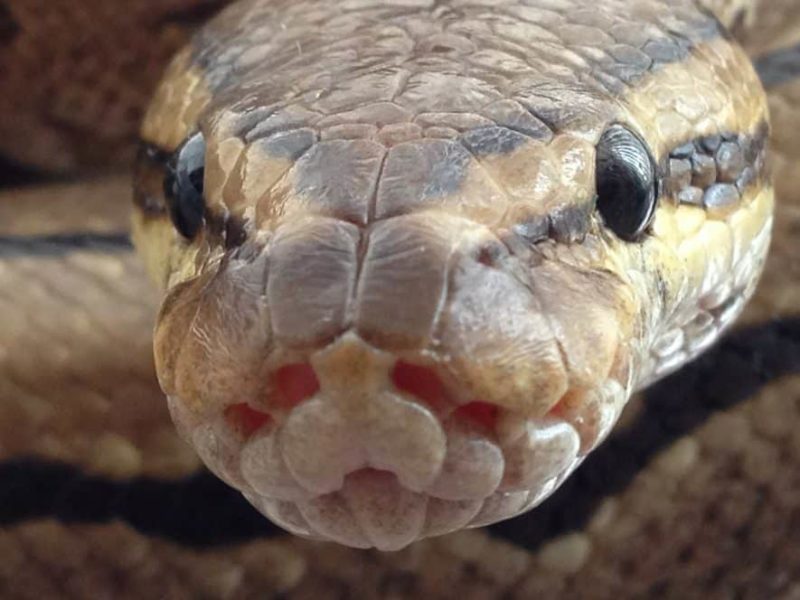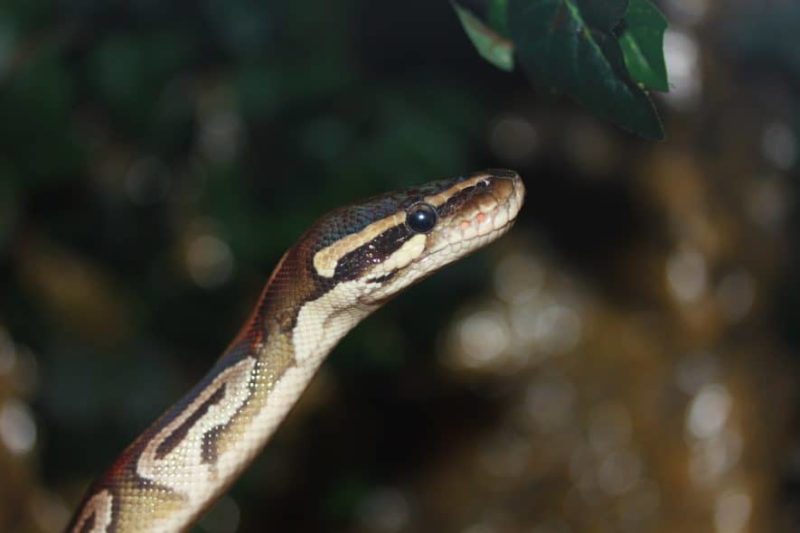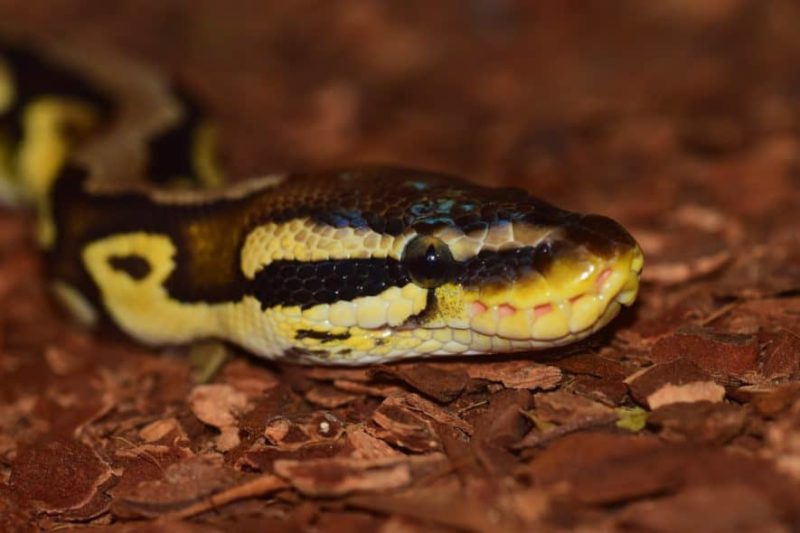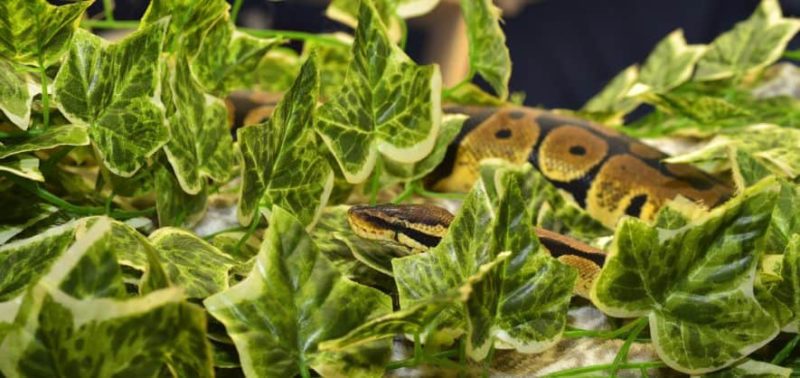When choosing a pet reptile you have to understand their health issues and typical behaviors. Some species can be challenging for beginners, so look for a pet that’s naturally hardy and easygoing – like the ball python (but only the captive-bred ones)
Early in my reptile-keeping journey, I worked with thousands of wild-caught ball pythons and almost all of them arrived with multiple health problems like tick infestations, respiratory infections, poor sheds, and infected wounds were very common in them.
But captive-bred ball pythons are a world apart. They are healthy, adaptable, and among the sweetest-natured snakes out there.
Honestly, what more could a first-time snake owner wish for?
Want to know more about the behaviors and illnesses of ball pythons? Keep reading!
Key Takeaways
- Healthy ball pythons typically lie in a flat coil, move slowly, often flick their tongues, and may lie in wait for food. When scared, they might hiss, flee, or curl into a protective ball.
- Ball pythons shed periodically, after every 4 to 6 weeks, or as rarely as once or twice per year
- Ball python bites are not dangerous and are very little painful.
- Handle your ball python in short, infrequent sessions to avoid stress.
- Respiratory infections, the inclusion of body disease, obesity, mites, and mouth rot are common health issues.
Quick Navigation
> Further Reading: The Complete Ball Python Care Sheet
Basic Ball Python Behavior and Body Language
You’ll notice your ball pythons performing a few common behaviors over time, including those explained below.
- Calm ball pythons move about slowly but purposefully.
- Ball pythons often flick their tongues while moving about to learn about their surroundings. This helps them gather information through scent particles that stick to their tongue and are analyzed by an organ in their mouth called Jacobson’s organ.
- Hungry ball pythons often lay motionlessly, with their head poised and ready to strike. They may also prowl slowly around the habitat seeking prey.
- When frightened, ball pythons may withdraw their head into an “S-coil,” hiss, flee or roll into a ball.
- Although it is somewhat rare, ball pythons can bite if they feel threatened or mistake your hand for prey.
Common Ball Python Behaviors: A Deeper Look
We’ll examine a few of the more noteworthy behaviors ball pythons exhibit below.
Shedding
Ball pythons, like all other snakes, shed their skin periodically. This can occur as often as once every four or six weeks for younger and healthy snakes, or as rarely as once or twice per year for adults, depending on the size, age, and health of the individual.
The shedding process starts with the snake’s belly turning a pinkish color and the overall scales appearing dull. A few days later, the eyes will take on a milky blue or opaque appearance. Following the blue eye phase, the snake’s colors will clear up again right before the shed occurs.
Proper sheds should come off in one long piece. But unfortunately, ball pythons who are sick, mite infested or dehydrated often shed in multiple pieces or fail to shed completely. This is called dysecdysis and can cause long-term health problems in some cases, so it is important to take steps to eliminate the problem.
Make sure your ball python’s enclosure has a proper humidity range of 50-60% at all times, with increased humidity (around 70-80%) during shed cycles. A hygrometer will be best to monitor these levels. And provide your ball python with a secure, humid hide, especially during its shedding cycle. Fill this hide with damp sphagnum moss to create a high-humidity safe space. Additionally, slightly damp substrate can help maintain humidity levels in the enclosure. Always provide a large enough water bowl for your snake to soak in if it chooses to.
Handling Stuck Shed:
If your ball python is having trouble shedding, there are safe and effective ways to help. Create a homemade humidity chamber using a plastic container with ventilation holes and a warm, damp towel placed inside. Place the container on a heating pad set to 85 degrees Fahrenheit (regulated by a thermostat). Once it gets warm, place the snake inside. And, cover the container with a cloth to reduce stress in your snake. Keep the snake in the chamber for no more than one hour, then return it to its enclosure. Repeat this process if the shed does not come off within 24 hours.
After using the humidity chamber, if you still see some stuck shed try gently aiding its removal using a damp cloth or cotton swabs. Always work in the direction of the scales. Do not force any scales off, especially near the eyes or the face.
Important Note: While soaking was once common advice but now it’s considered potentially stressful and even dangerous for ball pythons due to the risk of drowning snakeheads by many owners. Instead, use the humidity chamber method.
> Further reading: Ball Python Shedding: All You Need to Know
Biting
Biting is the behavior that often elicits the most attention from new keepers. This is understandable – nobody wants to be bitten by a snake.
However, it is important to note that ball python bites are rarely very painful, nor are they likely to cause much damage. Typically, they’ll cause a few minor breaks in the skin, which will ooze a trickle of blood.
Bites rarely require much more first aid than simple soap and water. However, if the bite displays any signs of infection (redness, swelling, etc.), contact your doctor. It is also important to feel the wound carefully to ensure no teeth were left in your skin.
> Further Reading: Does a Ball Python Bite Hurt (and Why Would Your Pet Bite)?
Handling Your Ball Pythons: Basics, Tips, and Tricks
Below, we’ll discuss the best way to handle your ball python, and then we’ll share a few tips and tricks that’ll likely make it easier and more enjoyable to do so.
Basic Ball Python Handling Procedure
Although you’ll certainly need to adjust to different circumstances and individuals, the best way to handle your ball python is as follows:
- Open the habitat and touch your snake gently on the back. This will help you avoid startling him if he’s sleeping (it is essentially impossible to tell if your snake is just sitting still or sleeping, as they lack eyelids).
- Place your fingers under his body gently and lift him off the cage floor quickly and decisively. Don’t stare at him for 10 minutes trying to gather your nerve; that’ll only make him nervous. Just pick him up.
- Once lifted, let your snake crawl freely around your hands and arms. Be sure to support him but avoid gripping his body tightly – that tends to make snakes feel threatened.
- After about 5 to 10 minutes (or you are done examining him, if that was your reason for picking him up in the first place), gently return him to his habitat and close the enclosure.
- Wash your hands with soap and warm water.
Tips and Tricks
Try to follow the procedure outlined above, but from time to time, you may find the following tips helpful:
- Learn to recognize your snake’s body language. Typically, ball pythons will communicate discomfort or fear long before they resort to biting. They’ll often do this by tensing their muscles, becoming more rigid, hissing or acting “jumpy.” If you note these signs, return your pet to his enclosure and leave him alone.
- If you must pick up a defensive ball python, use the “paper towel trick.” By simply covering your snake with a paper towel (or small hand towel, if your snake is large), you’ll find that most snakes calm down significantly. You can then pick up the entire package – snake and towel – and move him as necessary.
- A snake hook (or an improvised version thereof) can make some snakes feel more comfortable. After lifting the snake with the hook, you may be able to transfer him to your hand without a problem. Otherwise, you can simply use the hook to move him as necessary.
- Don’t handle your snake too often or for too long. Excessive handling will usually stress your snake out, so keep handling sessions brief. Also, don’t bring your snake to public places, as this is stressful to the snake and often upsetting to those who are not comfortable with snakes. This type of behavior only hurts the hobby.
- Because they’re nocturnal, ball pythons are generally easier to handle during the day. You’ll often find that your ball python will be more alert at night, and they’ll generally be less tolerant of handling during such times.
Caution: Don’t Handle Your Ball Python After Eating
Note that you should never handle your ball python who’s recently eaten. Doing so may cause him to regurgitate his last meal. This not only creates a thoroughly disgusting mess, but it is also stressful for the snake. It’s also a waste of money, as that rodent will now be useless.
As a general rule, the minimum you should wait after feeding before handling is 24 hours. However, it’s far safer to wait 48-72 hours (if your snake ate larger meals) to ensure complete digestion. This assumes that any bulge created by the meal has shrunk. If you can still detect a food bulge, do not handle your snake.
> Further Reading: The Ball Python Diet
Illness and Disease: Signs of a Sick Ball Python
Some of the most common health problems that afflict ball pythons are explained below. These are certainly not all of the possible diseases and conditions that may threaten your pet, but they deserve the most attention.
Respiratory Infections
Any snake can suffer from a respiratory infection, but snakes that hail from tropical areas – including ball pythons – are often especially susceptible to them. Because snakes cannot cough, they have great difficulty expelling the fluid which can accumulate in their respiratory tract. This means that a simple “chest cold” can quickly prove fatal in snakes.
A few of the most common symptoms of respiratory infections in ball pythons include:
- Blowing bubbles from the nostrils or mouth
- Wheezing, clicking, or gurgling sounds when breathing
- Drooling
- Labored breathing or open-mouthed breathing
- Food refusal
- Staying near the heat source more often than usual
- Lethargy or decreased activity levels
If you notice your ball python exhibiting any of these symptoms, temporarily raise the temperatures within your ball python’s enclosure slightly. Aim for the high end of their recommended temperature range to support their immune function.
While ball pythons occasionally recover from extremely mild respiratory infections without veterinary treatment, most will require medications to help combat the infection.
Inclusion Body Disease
Inclusion Body Disease (IBD) is a severe and deadly viral infection. It affects snakes within the boid family, which also includes ball pythons. Infected snakes show symptoms that include neurological problems (like stargazing, tremors, and disorientation), respiratory difficulties, and digestive issues such as regurgitation and weight loss. Sadly, there is no cure or treatment for IBD. As it’s highly contagious and causes a lot of suffering to the animal, euthanasia is only considered the most humane option to prevent the spread of the virus and end the snake’s suffering.
Prevention is always the key to IBD, and it’s important to only buy snakes from breeders who test for the disease, and strictly quarantine any new snakes for a minimum of 3-6 months. Cleaning the equipment and affected areas thoroughly is also essential – especially if your snakes have been exposed to the virus. If you think your ball python might have IBD, keep it away from other snakes and get help from a vet right away.
> Further Reading: How to Tell if My Ball Python Is Dying?
Obesity
Obesity can cause health problems for ball pythons, so it is important to keep your snake at the proper body weight. While experienced keepers are often able to accurately assess body condition, it is often difficult for novices to do so. Accordingly, beginners should visit their vet regularly (perhaps once per year) to ensure that their snake is in good health.
Some of the most notable locations in which ball pythons store fat include the rear portion of the head and the sides of the tail base. Additionally, the spine and ribs can provide clues to the snake’s body condition. You should be able to feel your snake’s ribs, but they should not be visible in most cases. A healthy ball python has a smoothly rounded, triangular body shape when viewed in cross-section.
Obesity takes a long time to treat in snakes – they don’t need very many calories in the first place. Accordingly, it is important to avoid the problem entirely by carefully managing your snake’s diet and feeding frequency.
> Further Reading: The Ball Python Diet
Eye Infections
A lot of new owners worry that their new ball python has an eye infection, but eye infections aren’t terribly common in snakes. I can only remember caring for one snake out of thousands that had a legitimate eye infection – and that was a water snake, not a ball python.
However, ball pythons do frequently experience two other eye-related problems:
- The eyes of dehydrated ball pythons will often dimple.
- Shedding difficulties can cause a snake to retain the scale covering its eye.
Unfortunately, it can be very difficult for beginners to distinguish between these two problems. So, the best thing to do is simply visit the veterinarian if you notice anything unusual about your ball python’s eye. Neither of these issues is terribly difficult for your vet to treat – he or she can likely remove a retained scale or help you rehydrate your pet.
Mites
The snake mite (specifically Ophionyssus natricis) is a tiny arthropod that feeds on the blood of snakes. And unfortunately, they are both extremely common and extremely difficult to eradicate – particularly for snake-keeping novices.
Individually, mites don’t represent much of a problem, although they’re probably irritating to the snake. But, when their numbers climb into the dozens, hundreds or thousands, they can cause serious physical stress. Death from mites is rare, but it is possible.
Mites essentially look like a moving speck of black pepper. They’re easy to spot against a white enclosure wall, but they’re very difficult to see on the dark portions of a snake’s body.
The easiest place to see them on your snake will be his ventral side, especially the portion under the chin (check in the crease running down the center of your snake’s lower jaw). You may also find them clustered around the eyes, mouth, or vent area.
Eradicating mites is complicated because the mature females are constantly leaving your snake, moving into the environment and depositing eggs. So, you’ll often have to utilize special medications that will kill the next generation of mites, or you’ll need to go to great lengths to eliminate the mites on your snake and those living in the environment.
In either case, beginners are wise to immediately seek veterinary assistance when confronted with mites.
> Further Reading: Mites in Ball Pythons
Mouth Rot
Mouth rot, also known as infectious stomatitis, is a bit of a catch-all term for various infections that manifest in the mouth of a snake. It is pretty disgusting – it can cause your snake’s mouth to bleed, ooze cheesy material, loose teeth or worse. Common culprits include Aeromonas, Pseudomonas, and various other opportunistic bacteria. But if caught quickly, you’ll usually be able to stop the problem.
Mouth rot can be caused by a variety of different things like small injuries in the mouth from prey, rough substrate, decor, weekened immune system and poor husbandry, so you’ll need to work with your vet to treat the animal. Just be sure that you do so quickly, as this problem can progress drastically in a short period of time.
Take Care!
Ball pythons are usually healthy and easy-going animals. You just have to start with a healthy, captive-bred individual and then provide the proper habitat, diet, and care. Just be observant and look out for the symptoms of illness mentioned above. This way, you’ll be able to act quickly and give your snake the best chance of recovery.










204 Comments
I don’t know what’s wrong with my ball python.
I first noticed he was wheezing, he had bubbles in his mouth, took him to the vet, no bubbles this time, had a piece of aspen in his nostril apparently, stopped wheezing.
Shortly after he came home, he started wheezing again, corkscrewing somewhat, if you turned him over he wouldn’t right himself, stopped eating.
But I’ve had him for 10 years, I have no other snakes, can it be IBD then??
Thank You.
Hi Andrew,
I understand your concern, and it’s wise to investigate the cause of these recurring symptoms in your ball python.
While you’re right that IBD (Inclusion Body Disease) is less common in snakes who are the sole pet, it’s not impossible.
Here’s what I suggest:
It’s important to consider that respiratory infections (RIs) are very common in ball pythons. Symptoms like wheezing, bubbles in the mouth, lethargy, and loss of appetite often point towards an RI. Since your snake experienced these signs, even after clearing a nasal obstruction, it’s possible that the RI wasn’t fully resolved, requiring further veterinary care.
Sometimes, stress (caused by changes in environment, handling, etc.) can exacerbate respiratory problems. Ensure your ball python’s enclosure is within the optimal temperature and humidity ranges. A vet might suggest additional diagnostics, like a respiratory culture or even an X-ray, to pinpoint the exact cause and severity of any infection.
Regarding IBD, it’s a virus and while less likely without other snakes in the house, it’s important to not rule it out completely. IBD can cause neurological symptoms like the corkscrewing and difficulty righting himself that you’ve described. A veterinarian may need to do specific tests to determine whether he has this virus.
I wholeheartedly recommend that you revisit your veterinarian as soon as possible. A thorough examination and appropriate testing will help determine the underlying cause and best course of treatment. In the meantime, keep a written log of any symptoms and behaviors you observe; this will be valuable information for the vet.
Please keep us updated on your snake’s progress.
My ball python who is 18 yrs old has developed red moist area on about 3/4 of his belly. He has been shedding for about 8 -10 days. Does he need to see a vet? Shall I soak him in water? I am concerned about soaking him because of his belly.
Thank you
Hi Mary,
I’m sorry to hear about your ball python’s belly issue. Given that he’s 18 years old and showing a red moist area on a significant part of his belly, it’s crucial to consult a reptile veterinarian immediately.
Such skin changes could hint at potential conditions like scale rot or infections. While shedding can cause some complications, the extended shedding duration you mentioned is concerning.
Although soaking might seem helpful, I’d advise against it without professional guidance, as it could aggravate the condition.
Please seek expert advice to ensure your snake’s well-being.
Ok, so my father split a 60 gallon tank into two sides with a glass divider in the middle so that my snakes can grow a bit before one of them needs the entire tank. At first, I had my male ball python (pin) on one side and my female boa (hypo jungle jaguar) in the other. I didn’t realize how flimsy the middle of the lid was so my male was with my female boa and they were wrapped around each other as if mated. I was not trying to breed any of my snakes right now, nor did I expect them to do that. I switch my male with my female ball python (banana) and I think “ok,they are both female, they won’t go into each other’s enclosure, everything is fine.” I and just before I go to sleep…my female BP is with my female boa. My boa is always on her side, the other snakes go to her side. They were fine, my boa was in her hide, and my BP was exploring the new side like they were best friends. I have had my boa for a few months and my ball python for 6 years, and I don’t know if snakes just like my boa, or if she wants a friend, but I don’t understand. Now I weigh down the middle of the lid with heavy rocks, and no one has been in the wrong side. But why was my female with my female just hanging out like nothing was wrong? I don’t understand.
Hello Bria,
Interesting observations! It’s important to know that snakes are generally solitary creatures. They don’t socialize or seek companionship like some mammals do. So, it’s unlikely your snakes were “hanging out” for social reasons.
What was probably happening is that your snakes were exploring new spaces, driven by their natural curiosity or perhaps an attractive scent (like residual rodent scent or the smell of the other snake).
It’s also important to note that housing different species together, even in a divided tank, can lead to stress and potential disease transmission, especially between boas and pythons. They have different habitat requirements and it’s crucial for their well-being to meet these separately.
I’d advise you to keep them in separate enclosures if possible, or ensure the divider is completely secure if you must use the same tank. You’re on the right track with weighing down the lid.
Hi Ben. I have a question. I was feeding my ball. He grabbed the rat n got caught on the edge of the container so I moved him back into the container so the rat wouldn’t fall out after he unravel. I didn’t put the top on the container, but I looked up n he’s coming out of the container , coming after me! I had to grab a shield to guide him back , he even bit the container I was using . Never done that before. Any reason why? It has been a while since he ate bc he was refusing meals . I was to nervous to grab him after that so I let him slither himself back into his home haha please let me know why he possibly reacted this way and what I can do to avoid that problem again. Thank you
Hey Wilbert
There could be a few reasons why your ball python reacted that way.
One possibility is that after feeding time if you or your hands have a feeder’s scent, it can trigger a ball python to strike. Ball pythons have very bad eyesight and rely a lot on their senses of smell and heat perception.
If you had fed your ball python recently and the feeding response was still activated, your snake probably thought that it was going to be fed again. If your hand smelled like a rodent, that would make the strike even more likely.
To avoid this problem in the future, you could try washing your hands after feeding to remove any scent from the feeder. You could also try using tongs or another tool to feed your snake so that your hands don’t come into contact with the feeder.
I hope this helps! Let me know if you have any other questions.
Hi,
I’m having a hard time with my husband’s ball python. She has refused to eat for nearly a year now, and we’ve both been very concerned for her health.
At the start, nothing had changed in her environment other than moving her entire enclosure from one state to another. Since then, we have changed her heat source and lighting, substrate, hides, and even the tank itself (IMO her original tank was too small), and nothing has been effective.
When we’ve tried live feeding, she seems to avoid the mouse altogether and shies away from it. As far as her overall health, there doesn’t seem to be anything noticeably wrong physically, so I’m clueless on what the problem could be. Unfortunately, we live in BFE where the vets around here know nothing about reptiles… hence why I’m resorting here. I’m happy to provide any other information or even pictures. Please help!
Hi Kiara,
I’m sorry to hear that your husband’s ball python has been refusing to eat for nearly a year. There could be several reasons why a ball python might stop eating. Some common reasons include stress, changes in temperature or environment, illness or disease, and seasonal changes. Moving her entire enclosure from one state to another could have caused stress and contributed to her refusal to eat.
It’s good that you’ve tried changing her heat source, lighting, substrate, hides, and tank. However, if she still refuses to eat, you could try adjusting your feeding strategy. For example, you could try offering her different types of prey or changing the way you present the food to her. You could also try scenting the prey with a different scent to make it more appealing.
Ball pythons can go without eating for around six to eight months, although in extreme cases, they’ve been known to last for over a year without any food. So while it’s concerning that she hasn’t eaten for nearly a year, there is still hope that she will start eating again.
I hope this information helps. Let me know if you have any other questions or concerns.
hi I have nearly 2yr old female ball python her last feed was 19th jan her set up is properly set up temperature and hides I change water everyday and tanks clean but since her last feed she has refused it ive tried feeding her when due but comes out has a look and backs off so I leave it overnight in vivarium but still there on morning so I throw it away I don’t no what to do because her last feed was 19th Jan I have weighed her 3wks ago and weighed her this week and she lost 16gramms can you help.
Hi Darrin,
I understand your concern regarding your female ball python. It is possible that the last meal may have tasted bad or had something wrong with it, which could have caused her to become off feed. It is also possible that she is having a natural period of decreased appetite due to environmental stress or hormonal changes.
There are several reasons why this might happen, including stress, incorrect temperature or humidity levels in their enclosure, seasonal changes, shedding, illness, or being picky about their food. If you have ruled out these potential causes, you could try offering her a different type of prey item to see if she is more interested. Additionally, I highly suggest taking her to the vet for an examination to ensure that there are no underlying health issues that might be causing her disinterest in food.
I hope this helps! Good luck
Hi! I got my blue eyed lucy ball python about a week ago, I’ve been pretty worried about everything since this is my first snake. We’ve been having trouble maintaining humidity, but the past few days we seem to have got it down better. Though he’s been shedding for a few days now too, and it’s coming off in pieces and I’m pretty sure there’s a good bit still stuck to him. It’s probably due to the inconsistent humidity but is there anything else that I could be doing wrong? And how can I help him finish shedding? I’m worried because I don’t know much about his behaviors and I don’t know what’s normal for him, he seems to be sleeping a lot today, I don’t really know what to do.
Don’t worry Victoria, it is normal for a snake to be sleeping a lot after shedding. You should make sure to keep the humidity consistent in your enclosure since improper humidity can affect how easily they shed and make them feel uncomfortable.
You can also help speed up the process by gently rubbing down their body with a damp cloth to help loosen any stuck pieces.
Make sure to never pull or tug on the stuck pieces as this could hurt your snake. You may also want to increase the temperature in his enclosure slightly for a few hours and see if that helps him shed quicker too.
If you would like to know more about ball python shedding, you can always check out our website for more info.
https://www.terrariumquest.com/ball-python/shedding/
Good luck!
Hey Ben,
I have a male ball python who’s about 3 years of age. This afternoon I noticed that his head was sticking up like he was looking at something. I found out the there is something called stargazing syndrome and I have been reading in to it. But what really caught me off guard was that when I change his water he usually flinches but when I changed his water today he didn’t do anything. He also hasn’t be going over on to the warmer side is the cage. Should I clean and sanitize his cage?
Hi Morgan,
I understand your concern. It sounds like it could be possible that your ball python is experiencing stargazing syndrome. This can happen due to a few different reasons such as dehydration, low temperatures, and poor husbandry practices.
The first step in addressing this issue is to make sure that your snake is warm enough and hydrated. Make sure that the temperature in his enclosure is not too low, and provide him with fresh clean water. You should also check to make sure that the humidity levels are appropriate for a ball python.
If these things are good, then I would recommend cleaning and sanitizing his cage just in case there’s something going on inside the enclosure that could be contributing to the stargazing. This could include things like mites, bacteria or parasites.
I hope this helps! If you have any further questions, feel free to reach out. Good luck!
I just got my ball python a week ago. I tried to feed it yesterday and followed all of the advice (feeding at night, dangling the mouse in front of him, making sure the mouse is nice and warm, etc.)
It didn’t really work. Instead of eating the mouse, he bit me.
I figured he was just stressed, so I lay the mouse in front of his hide and let him be. I checked back in a few hours later and found him using the mouse as a pillow. He wasn’t eating the mouse, but laying his head on it.
I called the reptile store I bought him from and they said that they were feeding him live. Is this just him being picky?
I would appreciate some advice on how to get him to eat. I am not particularly worried but I want him to eat the next time I try (which will be 2-3 days later).
Other than that, there is something I am more worried about. As a novice, I have frequently been checking up on him (during both day and night) and found him in the exact same place every single time. Not once had I caught him on the heat mat. The humidity levels are usually around 60-70%, and I’ve kept the heat mat at 86 F using a thermostat. I’m sure that nothing is wrong in his enclosure. Could there be any disease/health issue that causes him to be on the warmer side less, or is it just normal for him to curl up on the cool side?
P.S: I am wondering if it is ok to leave the mouse on the substrate for a few hours. Do I have to replace the substrate that the mouse was on if he doesn’t eat? Is it even alright to leave the mouse on the substrate I’m using? The substrate mix is Coco blocks and the Jungle Mix (the one that looks like dirt).
Hey Emily!
It’s possible that your ball python is just being picky. Some snakes will only eat live prey, while others will eventually learn to accept frozen/thawed prey. If you’re able to, try offering him both live and frozen/thawed mice and see if he’ll eat either one.
If he still refuses to eat, there could be a medical reason why he’s not interested in food. If your ball python hasn’t eaten in over two weeks, I recommend taking him to a reptile vet for a check-up.
As for the heat mat issue, It’s possible that your ball python is just more comfortable on the cool side hide, or that he likes the hide on that side better. If you’re worried about his health, you could try switching the hides to see if it makes a difference.
For substrate, It is perfectly fine to leave the mouse on the substrate for a few hours. You do not have to replace the substrate that the mouse was on if the ball python doesn’t eat.
I hope this helps! If you have any other questions, feel free to ask 🙂
Hey i just bought a baby normal ball python 3 days ago and it just now started to move around its tank and so i just noticed its constantly wobbling its head and neck all over while its moving if its not leaning against something is this normal or should i return it?
That’s perfectly normal, Ashley! Babies are usually a little more wobbly since their muscles aren’t as developed yet. Make sure to give them climbing opportunities in their enclosure, and when you have them out, to help strengthen their muscles. If it’s not improving after a few days or gets worse, then you can take it to the vet for a checkup.
Thanks!
Hi Someone Anyone Everyone Please Help!
My 2 Year Old Albino Ball Python Nova just scared me nearly to death! I rarely if ever take him outside of the home. Today was a nice day in Ga maybe high 80s/low 90s, so I took him out. As we were riding down the road, I saw a stream of what I thought was urine! Only to discover that it was like spit coming out his mouth! He wasn’t yawning no spit bubbles no wheezing funny noises or breathing hurdles. Despite the spit, he was acting normal before & after. He eats normally as well. I’m still worried and was thinking that being handled too much & the shock of outside may have stressed him out? Any thoughts? I’m hoping he doesn’t have a RI because the spit would be the only symptom being shown.
Hey Aynesha, it is difficult to say what the cause may be without seeing Nova. However, some common causes of spitting in snakes include dehydration, respiratory infection (RI), foreign body ingestion or regurgitation, and stress. If you are concerned, it is best to take Nova to a veterinarian for a check-up.
Hi! My ball python is healthy and eats perfectly fine. Cage temps range anywhere from 73-80 ambient and she has a heat mat as well that she usually likes. Humidity can range anywhere from 50-75 depending on if I’ve just sprayed the cage down.
So what is the issue? Well, a few times this has happened but it is random. I will find tiny little blood spots somewhere in the cage. It is usually like one or two little spots that could go ignored unless you look directly at it. Today I found a skinny line of it in her cage. What’s funny is that whenever I check her she has no marks or scabs anywhere, like it never happened.
The only thing I can think is that maybe it is because she is really rough in the cage? But I find no scabs. Let me know what you think of if you think that could be it and it’s nothing to worry about.
Thanks, Claire
oh, I just wanted to clarify 73-80 degrees F ambient temperature.
Thank you for reaching out, Claire. Everything sounds good with your setup and it’s great to hear that your snake is eating well.
Based on what you’ve described, it sounds like the blood spots could be from feeding. When snakes eat, they sometimes thrash around a bit and can accidentally break the skin, which can result in a tiny bit of bleeding.
If you don’t see any marks or scabs on your snake’s body, then it’s possible that your ball python is simply rubbing up against the cage walls or other surfaces in a way that’s causing some minor scrapes or cuts. This could account for the occasional blood spots you’re finding.
If your snake appears healthy and happy otherwise, there’s no need to worry too much about this. Just keep an eye on her and make sure the cage is clean and free of any sharp objects that could cause more serious injury.
However, if you start seeing more frequent or larger blood spots, it would be a good idea to take your snake to the vet to get checked out, just in case.
I got my ball python at 3 weeks old and he has eaten every 30 days, all 4 years we have had him. We could always expect him to become more active around 25-27 days in, especially when he notices someone come in the room, letting us know he’s hungry and ready to eat. Suddenly he’s extremely active, all the time (day & night) whether someone is in the room or not but he won’t eat. At first we thought the rat might be too big so we got a smaller one but he doesn’t even acknowledge it. We offer him the rat every 3-4 days and are going on month 2 of not eating but overly active. When I hold him he settles down and sleeps on me but is often unsettled in his tank. What’s wrong with my baby, Please help!
Hey Samantha,
If your ball python is four years old, then he is likely an adult and may no longer be a juvenile. Adult ball pythons can go weeks or even months without eating, so don’t worry too much about that.
However, if your ball python is not eating, then you should bring him in for a check-up to make sure there is not something wrong. Ball pythons who are not eating may have a health problem that needs to be addressed.
Thanks!
I have a juvenile ball python that we bought at the end of October. He has only had one shed since then. Everything I’ve read since then has said young ball pythons shed every 4-6 weeks. Everything else about him seems normal and healthy. His humidity levels are good, his temps are good, he eats well, he has regular periods of hiding and regular periods of moving around his enclosure. He seems to enjoy being handled, never shows any signs of stress or fear. We contacted the breeder and he just said “they shed when they shed,” and didn’t seem concerned, but I wanted another opinion! Thanks!
Hi Leesa!
There are a few reasons that cause the shedding problems:
1. One possibility is that the humidity levels in his enclosure are too low, which can cause shedding problems. Make sure that you are providing a humidity gradient in the enclosure (i.e., a dry area and a humid area), and that the humidity levels are staying above 50%.
2. Another reason may be Your python might not be getting enough food. If he is not eating well, this can also impact his shedding cycle. Make sure that you are offering him an appropriate-sized meal every 7-10 days, and that he is accepting it.
3. It is also possible that your python is simply shedding less frequently than other ball pythons. Some snakes shed more often than others, and there is no set schedule that all ball pythons will follow. If your snake appears healthy and is eating well, there is no need to be concerned.
Hope it helps!
I recently got a banana pied baby from Petsmart, whenever I take him out he opens his mouth a little a few different times when I’m holding him, but doesn’t do it when hes in his tank. There’s no weird sound coming out of his mouth or nose, no discharge or stuck shed. He’s also in mid shed. Is that normal? I’ve read it could be him checking his surroundings but I’m also afraid of a RI. His temps and humidity are fine.
Hi Lindsay!
A banana pied baby snake might open its mouth when exploring its surroundings, especially if it is new to the area. Snakes learn about their surroundings by tasting the air around them.
Most of a snake’s sensory information comes from smell, and they have more than one way to receive scent messages.
If there is no discharge or stuck shed, and the temperatures and humidity are fine, then it is likely that your snake is just adjusting to its new environment.
I was handling my snake and they (idk the sex) gripped around my arm and when I moved them I had these two red marks on my arm. Only about 1/2 inch apart. They were really active and moving around a lot when I tried putting them back they tried squeezing my arm again. I just wanna know why they did it or what they did
Hi Haley!
It might be possible that your snake was feeling threatened. If you were handling them roughly, or if they felt like they were in danger, they may have bitten you as a defense mechanism or your snake was just being playful.
Snakes are not typically aggressive towards humans, but some individual snakes may be more prone to biting than others. Either way, it’s important to be careful when handling your snake to avoid getting bitten.
I got my lavender albino ball python on october 26th. And the place i got him from said he ate on the 21st. It’s the 31st now and im not sure if he is still settling in or not but he wont eat. Not sure if the hide i got him is too big or not because he goes in it sometimes and most the time he just goes behind it and stays there for most the day and usually when i walk in the room he’ll come out for about 10 minutes then go back to hiding. He drinks the water i give him but he isn’t eating…should i be worried or is that normal?
Hi Brandon,
Changing a snake’s enclosure can definitely cause some upset, so 10 days of not eating is fairly normal. I would place some more hides in his enclosure, make sure he has a moist hide, check your temperatures and make sure there are no other pets like cats around to cause him extra stress. Monitor your pythons weight, if he is not losing any then I wouldn’t start to panic just yet. Many snakes also eat far less frequently during the winter months, so depending on where you are based this may have an effect. Get in contact again if he ends up not eating for a month.